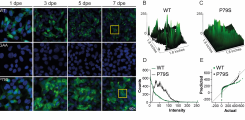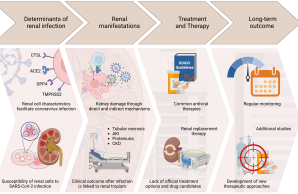Molecular Virology of Emerging Viruses - Projects
-
Viral Variants
Viral Variants
Approximately 22% of the global population display at least one underlying condition, which puts them at higher risk of adverse outcomes for infectious diseases. Indeed, the recent SARS-CoV-2 pandemic highlighted the vulnerability of specific populations with co-morbidities towards less favourable disease outcomes. Amongst those, immunosuppressed patients have become the focus of attention. This group includes individuals with various malignancies and immunologic diseases, as well as patients who have undergone solid organ transplantation. The latter are typically treated with immunosuppressive drugs.
There is a consistent body of evidence reporting prolonged or chronic infections with SARS-CoV-2 in immunocompromised individuals. Certain reports even proposed that SARS-CoV-2 Variants of Concern (VOCs) which became globally dominant, including the Alpha variant, are thought to originate from individuals with compromised immune systems. This phenomenon has been observed in chronic infections with several viruses, such as DENV and hepatitis E virus (HEV). Continuous replication of the virus potentially favours the accumulation of mutations in order to adjust to environmental and immunological pressure and therefore presumably facilitates the emergence of new variants with enhanced epidemic potential. Additionally, immunocompromised patients often require pharmacological interventions to clear infections, which may also further drive viral mutagenesis. Direct acting antivirals such as the nucleotide analogue Remdesivir or Ribavirin (RBV) facilitate a so-called “error catastrophe” during viral replication, which leads to defective or replication-incompetent viral genomes and subsequent viral extinction. However, in some cases the selective pressure drives viral mutagenesis leading to the formation of intra-host populations.
The emergence of novel viral variants presents a risk to the general population by affecting various aspects such as transmission dynamics, public health measures, vaccine efficacy, antiviral treatment, disease severity, and pathogenesis, among others. Therefore, it is crucial to thoroughly investigate potential drivers of mutagenesis and understand the impact of specific mutations.
Here, we aimed to explore viral replication under immunosuppressive or antiviral therapy to better predict and manage the spread of variants, potentially leading to the development of new antiviral drugs and therapeutic strategies.
Publications
Meister TL, Brüggemann Y, Nocke MK, Ulrich RG, Schuhenn J, Sutter K, Gömer A, Bader V, Winklhofer KF, Broering R, Verhoye L, Meuleman P, Vondran FWR, Camuzet C, Cocquerel L, Todt D, Steinmann E. A ribavirin-induced ORF2 single-nucleotide variant produces defective hepatitis E virus particles with immune decoy function. Proc Natl Acad Sci U S A. 2022 Aug 23;119(34):e2202653119. doi: 10.1073/pnas.2202653119. Epub 2022 Aug 15. Link
Wißing MH, Meister TL, Nocke MK, Gömer A, Masovic M, Knegendorf L, Brüggemann Y, Bader V, Siddharta A, Bock CT, Ploss A, Kenney SP, Winklhofer KF, Behrendt P, Wedemeyer H, Steinmann E, Todt D. Genetic determinants of host- and virus-derived insertions for hepatitis E virus replication. Nat Commun. 2024 Jun 6;15(1):4855. doi: 10.1038/s41467-024-49219-8. Link
-
Viral Tropism
Viral Tropism
Viral tropism, the tendency of viruses to infect specific cell types or tissues within a host organism, is a fundamental aspect of viral pathogenesis. The ability of a virus to target and infect particular cells is determined by a complex interplay of viral and cellular factors. Some viruses exhibit a narrow tropism, infecting only a limited range of cell types, while others display a broader tropism, infecting multiple cell types throughout the body. Viral tropism can play a critical role in determining the outcome of infection. Understanding why certain viruses cause more severe disease in some individuals compared to others is crucial for developing effective treatments and preventive measures.
Therefore, we explore the intricate interactions between viral pathogens and their hosts, including host immune responses, viral genetic diversity, microenvironmental factors, and cellular susceptibility. By elucidating these factors, we aim to improve our understanding of viral pathogenesis and uncover the specific interactions between viral pathogens and host cells to identify novel drug targets and develop strategies to block viral entry or replication selectively.
PublicationsBärreiter VA, Meister TL. Renal implications of coronavirus disease 2019: insights into viral tropism and clinical outcomes. Curr Opin Microbiol. 2024 Jun;79:102475. doi: 10.1016/j.mib.2024.102475. Epub 2024 Apr 13. Link
-
Antiviral Targets
Antiviral Targets
Viral infections pose a significant global threat, contributing to disease, mortality, and economic losses. This raises significant concerns, especially given the limited availability of antiviral drugs for treating viral disease. Recent viral outbreaks including Zika (ZIKV), Ebola (EBOV), and the more recent SARS-CoV-2 pandemic highlight the urgent need for novel antiviral strategies. Therefore, identifying and targeting specific molecular components of viral entry, replication, and assembly processes offer promising avenues for intervention. Targeting viral entry mechanisms, such as viral surface glycoproteins and host cell receptors, can block the initial stages of infection and limit viral spread within the host. Additionally, one key antiviral target is viral replication machinery, including enzymes essential for viral genome replication and protein synthesis. Inhibiting these enzymes can disrupt viral replication cycles, preventing the production of infectious viral progeny. Host factors essential for viral replication and propagation also serve as potential antiviral targets. By disrupting host-virus interactions or modulating host immune responses, we can inhibit viral replication and reduce disease severity.
We aim to find agents that may exploit conserved viral structures or host factors shared among different viral families, providing a versatile approach to combating diverse viral infections.
Publications
Schuhenn J, Meister TL, Todt D, Bracht T, Schork K, Billaud JN, Elsner C, Heinen N, Karakoese Z, Haid S, Kumar S, Brunotte L, Eisenacher M, Di Y, Lew J, Falzarano D, Chen J, Yuan Z, Pietschmann T, Wiegmann B, Uebner H, Taube C, Le-Trilling VTK, Trilling M, Krawczyk A, Ludwig S, Sitek B, Steinmann E, Dittmer U, Lavender KJ, Sutter K, Pfaender S. Differential interferon-α subtype induced immune signatures are associated with suppression of SARS-CoV-2 infection. Proc Natl Acad Sci U S A. 2022 Feb 22;119(8):e2111600119. doi: 10.1073/pnas.2111600119. Link
Schrader JA, Burkard TL, Brüggemann Y, Gömer A, Meister TL, Fu RM, Mehnert AK, Dao Thi VL, Behrendt P, Durantel D, Broering R, Vondran FWR, Todt D, Kinast V, Steinmann E. EGF receptor modulates HEV entry in human hepatocytes. Hepatology. 2023 Jun 1;77(6):2104-2117. doi: 10.1097/HEP.0000000000000308. Epub 2023 Feb 7. PMID: 36745934; Link
-
Disinfection
Disinfection
Emerging viruses pose significant threats to global health due to their potential to cause widespread disease outbreaks and pandemics. Recent examples include the coronavirus disease 2019 (COVID-19) pandemic caused by severe acute respiratory syndrome coronavirus 2 (SARS-CoV-2) or Zika virus linked to congenital abnormalities. These pathogens often originate from zoonotic reservoirs, evolving rapidly to exploit new hosts and environments. A major obstacle in addressing emerging viruses is the frequent lack of vaccines and specific antiviral treatments during the early stages of an outbreak. In these instances, hygiene measures become the first and most critical line of defence to curb transmission. Among the most effective hygiene interventions are disinfectants. By investigating the factors influencing the efficacy of various disinfectants against different viral pathogens, this research aims to provide insights into optimizing disinfection protocols and contributes to more targeted and effective hygiene interventions. Hence, we conduct to evaluate the antiviral efficacy of oral rinses and their active ingredients, World Health Organisation (WHO)-recommended hand rub formulations I (ethanol based) and II (2-propanol based), as well as surface disinfectants and may more.
Different pathogens exhibit unique susceptibilities to disinfection methods, often requiring tailored solutions. Therefore, choosing appropriate disinfectants with proven efficacy against target viruses and following manufacturer instructions for proper application are essential for effective viral control and infection prevention.
Publications
Meister TL, Brüggemann Y, Todt D, Conzelmann C, Müller JA, Groß R, Münch J, Krawczyk A, Steinmann J, Steinmann J, Pfaender S, Steinmann E. Virucidal Efficacy of Different Oral Rinses Against Severe Acute Respiratory Syndrome Coronavirus 2. J Infect Dis. 2020 Sep 14;222(8):1289-1292. doi: 10.1093/infdis/jiaa471. Erratum in: J Infect Dis. 2021 Feb 13;223(3):541. doi: 10.1093/infdis/jiaa539. PMID: 32726430; PMCID: PMC7454736.
Meister TL, Friesland M, Frericks N, Wetzke M, Haid S, Steinmann J, Todt D, Pietschmann T, Steinmann E. Virucidal activity of oral, hand, and surface disinfectants against respiratory syncytial virus. J Hosp Infect. 2023 Nov;141:25-32. doi: 10.1016/j.jhin.2023.08.009. Epub 2023 Aug 23. PMID: 37625461.
Meister TL, Frericks N, Kleinert RDV, Rodríguez E, Steinmann J, Todt D, Brown RJP, Steinmann E. Inactivation of yellow fever virus by WHO-recommended hand rub formulations and surface disinfectants. PLoS Negl Trop Dis. 2024 Jun 20;18(6):e0012264. doi: 10.1371/journal.pntd.0012264. PMID: 38900788; PMCID: PMC11218936.
Meister TL, Tao R, Brüggemann Y, Todt D, Steinmann J, Timm J, Drexler I, Steinmann E. Efficient Inactivation of Monkeypox Virus by World Health Organization‒Recommended Hand Rub Formulations and Alcohols. Emerg Infect Dis. 2023 Jan;29(1):189-192. doi: 10.3201/eid2901.221429. Epub 2022 Nov 17. PMID: 36394568; PMCID: PMC9796202.



